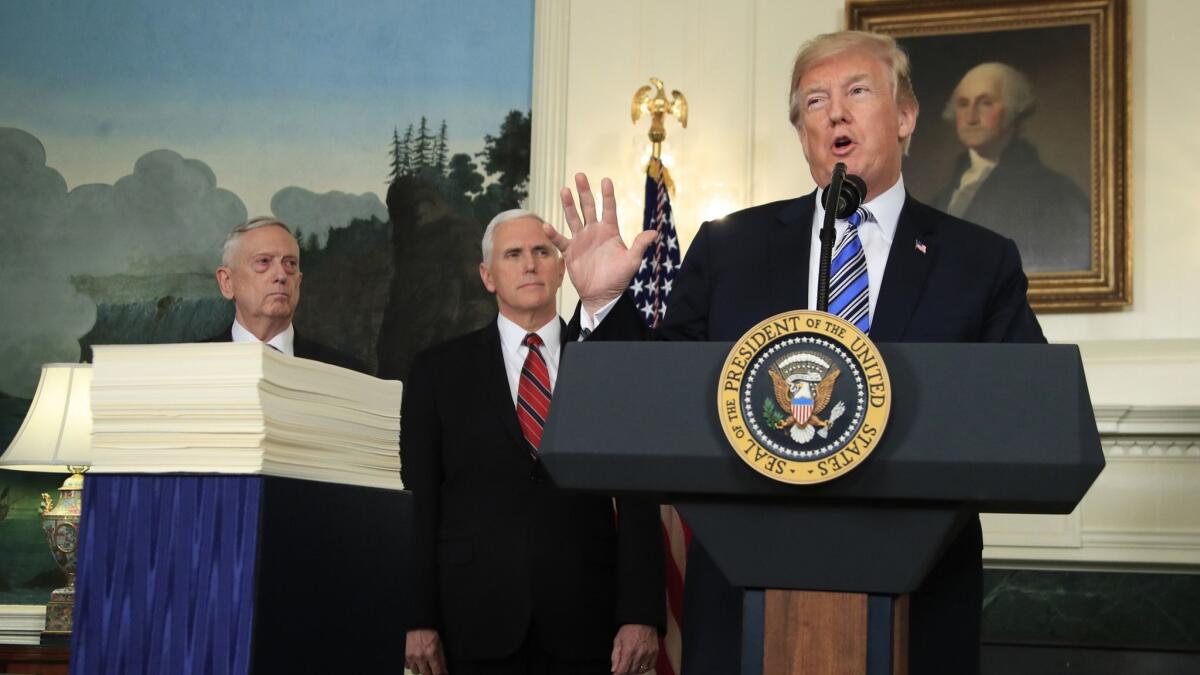Budget office projects growing deficits and massive debt during Trump administration

Reporting from Washington — Propelled by the Republican tax-cut plan and increased government spending favored by both parties, the nation’s deficit will top $1 trillion by 2020 and its debt burden within a decade will approach rates not seen since the aftermath of World War II, the Congressional Budget Office said Monday.
The budget deficit next year will rise to $804 billion, or $139 billion higher than the estimates made before the $1.5-trillion tax plan and $1.3-trillion spending bill were signed into law by President Trump in December and March, respectively.
The national debt will rise from nearly $16 trillion at the end of 2018 to almost $29 trillion by 2028, the nonpartisan office said.
“The bigger the debt, the bigger the chances of a fiscal crisis,” CBO Director Keith Hall warned Monday, noting that debt as a percentage of the gross domestic product in 2028 will be the highest since 1946.
RELATED: See CBO’s 10-year U.S. budget projections »
He said that the expansion of debt was particularly troublesome during a time of economic growth, rather than in response to a recession, such as after the 2008 financial collapse.
“We’re quite a few years off a recession and we have very high deficits,” Hall said.
The last CBO report issued during the Obama administration said that after a $587-billion deficit in 2016, the shortfall was expected to break the $1-trillion mark in 2023, rising to $1.4 trillion in 2027. The total budget deficit over the 10-year span beginning in 2017 was projected to be $9.4 trillion.
The new report said the shortfall will now hit $12.4 trillion over the span ending in 2028, after breaking the $1-trillion mark in 2020. That’s three years earlier than expected, because of the tax cut and spending plans.
Neither Republican congressional leaders — who railed against President Obama’s deficit spending — nor President Trump, who once vowed to balance the budget, had any immediate comment on the report.
The CBO also confirmed earlier estimates that despite Republican promises that the tax cuts would pay for themselves through economic growth, the plan would actually increase the deficit about $1.9 trillion over 11 years.
Democrats said the report rebuked Republicans’ claims to be fiscal conservatives.
“In their craven haste to give corporations and the wealthiest 1% massive tax breaks, Republicans saddled our children and grandchildren with trillions of dollars of debt,” House Minority Leader Nancy Pelosi (D-San Francisco) said in a statement.
Democrats warned that Republicans may next try to slash Social Security and Medicare in an effort to pare back the deficit they’ve made worse. Some House Republicans have floated the idea of a balanced budget amendment, which would require huge cuts to discretionary programs and those that support older and sick Americans. It is unlikely to pass the Senate.
“From Day One, the Republican agenda has always been to balloon the deficit in order to dole out massive tax breaks to the largest corporations and wealthiest Americans, and then use the deficit as an excuse to cut Social Security and Medicare,” said Senate Minority Leader Charles E. Schumer (D-N.Y.).
“The American people deserve a Congress that is focused squarely on helping the middle class, not patronizing Kabuki theater — like sham ‘balanced budget’ votes — from Republicans who blew up the deficit to benefit wealthy special interests.”
Democrats, however, contributed to the the deficit’s additional rise by supporting the March spending measure, which gave Republicans higher military spending and Democrats a boost in domestic funding.
The CBO estimated that by 2027 the national debt would comprise 88.9% of the gross domestic product, just below the level at which economists say its load would harm the economy.
The new report said that by 2028, the debt load will exceed 96% of GDP. If individual tax cuts created in the GOP plan are extended beyond their current expiration in 2026 — as many expect will occur — the negative impact on the debt would be even more pronounced.
The CBO is the nonpartisan agency charged with delivering independent analysis of the economy, budget bills and other legislation.
Last year, congressional Republicans and the Trump administration criticized the CBO as lacking credibility after it delivered negative assessments of GOP healthcare bills. Historically it has been considered a dependable source of fiscal predictions, even as legislators have ignored its increasingly heated warnings about the national debt.
Trump has routinely ignored the debt and deficit when it has come to advancing programs that are popular among his voters. During the campaign, he advocated protecting numerous expensive programs — including Social Security and Medicare — and never explained how he would finance them. Neither did he focus on the fiscal impact of the tax cuts he favored.
His formal budget proposals have been far more harsh toward non-military spending, but the Republican-led Congress has pushed against his proposed cutbacks in social programs because of their political unpopularity and the need to attract Democratic votes to pass any plan.
While the report offered Democrats substantial ammunition in a campaign year, it offered the president some limited good news.
The average economic growth will rise 0.7 percentage points as a result of the tax plan, and about 1.1 million jobs will be added, the report said. That, in turn, will also boost the gross domestic product.
But the CBO predicted that interest rates will rise as a result of the increasing debt. And economic growth overall will be, on average, 1.9% — well below the 3% growth that Trump has long touted as an easy result of his policies.
Strikingly, the CBO report underscored how the options ahead for legislators and the president are narrowing. Over the next 10 years, for example, Social Security spending will rise to 6% of GDP and healthcare costs to 6.6% — both the outgrowth of the retirements of baby boomers and factors whose curtailment would be politically difficult.
But they do not represent the fastest-growing segment of federal spending. That would be interest on the debt, which will double to 3.1% of GDP over the next 10 years.
For more on politics from Cathleen Decker »
Twitter: @cathleendecker
UPDATES:
4 p.m.: The article was updated with additional details from the Congressional Budget Office report and reaction from Democrats.
The article was originally published at 11:15 a.m.
More to Read
Get the L.A. Times Politics newsletter
Deeply reported insights into legislation, politics and policy from Sacramento, Washington and beyond. In your inbox three times per week.
You may occasionally receive promotional content from the Los Angeles Times.











